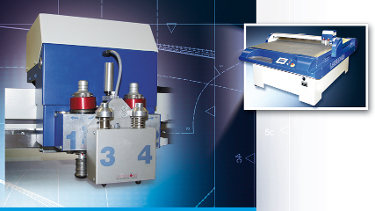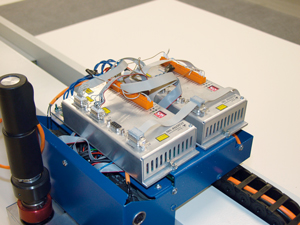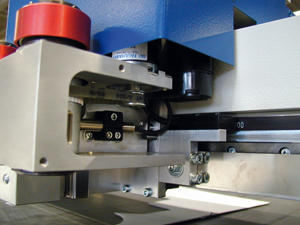 |
| August 18, 2015 | Volume 11 Issue 31 |
Designfax weekly eMagazine
Archives
Partners
Manufacturing Center
Product Spotlight
Modern Applications News
Metalworking Ideas For
Today's Job Shops
Tooling and Production
Strategies for large
metalworking plants
DC Motor Applications: Micro coreless motors power precision plotter/cutting systems
Miniature drives for the redesign of a cutting plotter.

Practically all modern products require protective packaging for shipment and handling. Paper remains the No. 1 choice of material because, in the form of cardboard or (corrugated) cartons, it allows a multitude of customized design options. Prototype models are essential for the quick testing of packaging design and functionality. Making them by hand is too expensive and imprecise, but handy cutting plotters can come to the rescue for in-office prototype fabrication, converting CAD data directly into finished cut samples in minutes.
Cutting systems for major series are expensive; stamping tools also cost a lot of money. So it's a good idea to test a new design on prototypes before making expensive investments. Lasercomb of Notzingen, Germany, a specialist in system solutions (including cutting equipment) for the packaging and diemaking industry, has developed a new generation of multifunctional plotters/cutters for such purposes. Reliability, precision, and an attractive price are right at the top of the specification. To make the machines requires in-depth know-how of plotter technology and a powerful coreless dc motor (series: 3557 CS) for the compact drive. To realize the demanding specifications, the manufacturer also works with its long-term drive supplier, FAULHABER. This means proven modules can be employed and concept optimization can happen rapidly as new ideas evolve.

Compact and maintenance friendly
Initially, Lasercomb's goal was to develop a small, reasonably priced plotter with all the features of its big brother. But a straightforward transfer of the concept into a smaller version was not possible; the cabling costs alone would have taken it out of the price range. Hence, the decision was made to use a compact CNC (computer numerical control) machine in the top-hat module. A second innovation was to incorporate two CAN-open nodes, thus minimizing the cabling costs. One node is responsible for the inputs/outputs as a control bus, and the other, cycled at a higher frequency, operates as a control bus for the drives. This ensures rapid and precise guidance of the tool in the tool head. The new design also afforded a reduction in the number of trailing cables to the head -- from 17 to just one cable, including the power supply, in the first draft.
The Lasercomb ProDigi plotter provides maximum performance, despite its extremely compact construction. Depending on the model, work surfaces of 800 x 1,300 mm to 3,100 x 1,700 mm from the tool head are traversed at speeds of up to 100 m/min (1.66 m/s) and an acceleration of 5 m/s, saving time during empty runs. In full cutting operation, it achieves up to 30 m/min, and as a drawing plotter it can even reach 50 m/min. A simple change of tools on the head is all that is required for reconfiguration; the electronics then adjust the cutting or drawing parameters via the sensitive controllable motors -- all of which is performed at a very low noise level, making it ideal for in-office use. The drive power required by the plotter and the tools is provided by state-of-the-art dc motors. Some users even produce their small-series packaging runs on these robust ProDigi plotters.

Custom-made DC miniature drives
Once the characteristics of the plotter were specified, the designers had to select the drive components to meet these specifications. As they have done for more than 10 years, they started work on this design with FAULHABER right from the outset.
The compact dimensions of the motors in the tool head were the most important aspect in this case. Here, four motors must be mounted in a limited space for controlling the Z-axis (i.e., knife stroke movement) and the C-axis (i.e., horizontal movement of the head). Each pair of motors is responsible for a tool fixture.
All motors are pre-configured with connection cables and incremental encoders. The connectors are then simply attached to a "switching panel" that provides the connections for the motor and the add-on modules, as well as the special plug configuration for the control side.
The advantage of this solution is that, in an emergency, the customer himself can replace the motor using "plug and play," which means the customary resoldering of special connections required in the past is no longer necessary. A seal against the inevitable paper dust also improves the lifetime of the robust motors; without disruptive foreign bodies, the frictional pairing of brushes and collectors is subject to much less wear.
To guide the cutting knife to the precise height, a 28-W motor with 180-mNm torque at a diameter of 35 mm and length of 57 mm is installed in the head. With a lifting spindle as a self-locking gear reduction, the cutting knife can be precisely positioned with zero backlash. In contrast, complete motor gear units consisting of an 80-W motor with 530 mNm and flanged metal planet gears are used for the C-axis. The high dynamics of the dc motors permit digital table height compensation (vertical tool tracking) over the entire work surface, thereby enabling a high degree of precision. This ensures a constant distance from the tool to the vacuum table and, hence, also to the material to be processed.
Nowadays, miniature drives can be individually adjusted to the desired requirements just like their big brothers. If the drive is matched with the application requirements from the outset, many problems and compromises that may arise with standard motors can be avoided during the design. This means special characteristics in the type of construction, performance, electromagnetic compatibility, "plug and play," or sealing against specific media are also easy to implement. The user saves his own development time and is quicker to market with his product -- an advantage that is otherwise difficult to achieve.
Video Note: This is the earlier-generation machine, just to give an idea of how the configurable plotter/cutter works.
Contact MICROMO today to speak with an application engineer to begin creating a customized motor solution for your needs.
Source: MICROMO
Published August 2015
Rate this article
View our terms of use and privacy policy
